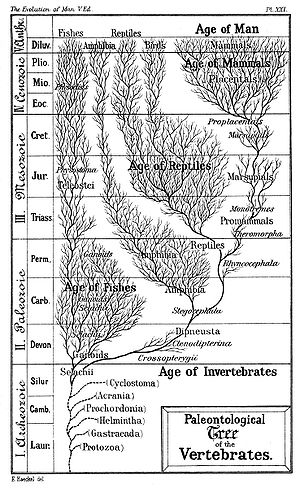
Back Філагенез Byelorussian Filogeneza BS Fylogeneze Czech Phylogenese German Kladogenezo Esperanto Fülogenees Estonian Törzsfejlődés Hungarian Ֆիլոգենեզ Armenian Филогенез Kazakh Филогенез Kirghiz

Phylogenesis (from Greek φῦλον phylon "tribe" + γένεσις genesis "origin") is the biological process by which a taxon (of any rank) appears. The science that studies these processes is called phylogenetics.[1][2][3][4][5]
These terms may be confused with the term phylogenetics, the application of molecular - analytical methods (i.e. molecular biology and genomics), in the explanation of phylogeny and its research.

Phylogenetic relationships are discovered through phylogenetic inference methods that evaluate observed heritable traits, such as DNA sequences or overall morpho-anatomical, ethological, and other characteristics.
- ^ Mayr E. (2005). Das ist Evolution. München: Goldmann. ISBN 3-442-15349-2.
- ^ Storch V, Welsch U, Wink M (2007). Evolutionsbiologie. Berlin/Heidelberg: Springer Verlag. ISBN 978-3-540-36072-8.
- ^ Hadžiselimović R. (1986). Introduction to anthropogenesis theory/Uvod u teoriju antropogeneze. Sarajevo: Svjetlost. ISBN 9958-9344-2-6.
- ^ Nipam H, Patel NH (2007). Evolution. Berkeley: Cold Spring Harbor Laboratory Press. ISBN 978-0-87969-684-9.
- ^ Bowler P. J. (2003). Evolution: the history of an idea (3rd ed.). Berkeley: University of California Press. ISBN 978-0-520-23693-6.
© MMXXIII Rich X Search. We shall prevail. All rights reserved. Rich X Search